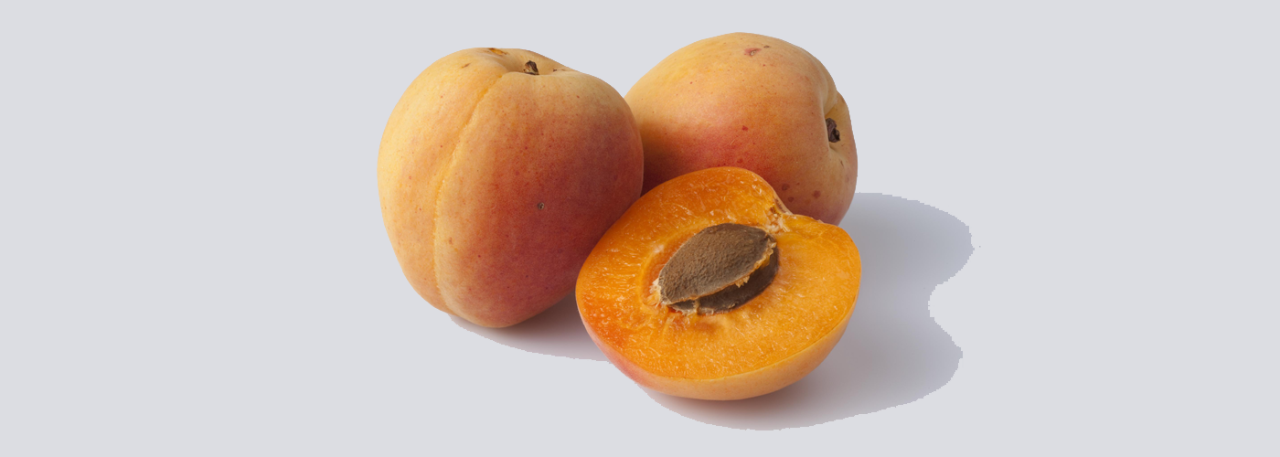.png.transform/rendition-xs/image_image%20(1).png)
Apricot
Although there are different types of apricot tree, the most widely-grown in Spain is the species Prunus armeniaca, which has rounded fruits with a diameter of about 3 cm / 1 in, soft skin, and a yellowish-orange color with touches of red. The fruit is very flavorful when it is at its optimum stage of ripeness, and has a pleasant and distinctive sweetness. The flesh (white, yellow or with an intense orange color) may be attached to the stone to a varying degree, and with varying juiciness and aroma.
Tasting notes
Soft, yellowish-orange skin with some red areas. It is very flavorful when it is at its optimum stage of ripeness, and has a pleasant and distinctive sweetness. The flesh (white, yellow or with an intense orange color) may be attached to the stone to a varying degree, and with varying juiciness and aroma.
Other notes
Compared to other fruits, apricots are low in calories due to the large quantity of water they contain and their low carbohydrate content. They have a high fiber and pro-vitamin A (beta-carotene) content, and are also a good source of minerals as they are rich in potassium, and to a lesser extent in magnesium and calcium.
Production / Processing method
Bulida
Rustic variety typically found in Spain which can adapt to all kinds of soils, even dry soils. It has very vigorous trees with abundant and regular production. The fruits are large, with a shallow groove, yellow skin and sweet, fairly juicy and sweet-smelling flesh. The stone is large and has a ridge. Harvesting takes place in early June.
Canino
Spanish variety of vigorous trees with rough leaves, resistant to fruit drop. The fruits are large or very large, almost round, with an intense yellowish-orange color, slightly red on the side exposed to the sun. The flesh is firm with a pleasant, perfumed flavor; the stone is average in size with a small ridge. Harvesting takes place in June, and the fruit keeps well and is resistant to transport.
Nancy
Vigorous trees with medium production, good resistance to pests, not demanding with regard to soils, but with fairly frequent fruit drop in clayey terrain. The fruit is very large, a little swollen at the base, almost spherical and with a stud at the end. It has a golden yellow color streaked with red, and the skin is fairly thick with several small bumps. The flesh is copper colored, perfumed, with a delicate taste, melting and sweet, juicy and a little tart. The stone is rather large, rounded and with a wide ventral ridge. Harvesting takes place in July, and the fruit keeps well during transport. This fruit has a very high commercial value.
Paviot
This variety has very vigorous trees with medium production, resistant to pests and sensitive to fruit drop. It requires healthy well-drained soils. The fruit is very large, orange in color and deep red in the sun. The flesh is yellow, extremely delicate, pleasant, melting and perfumed, with a medium-sized stone. Harvesting takes place between July and August, and the fruit has an acceptable resistance to transportation. These apricots are of excellent quality and commercial value.
Moniquí
This tree is fairly vigorous and has a somewhat irregular production. The fruit is thick, oval and flattened, pinkish white in color and with a transparent appearance. The flesh is white and juicy, perfumed and sweet. The stone is semi-attached to the flesh. Harvesting takes place between June and early July. This fruit is highly recommended for eating.
Currot
This is the earliest commercial variety to appear on the market. These are small fruits, delicate pinkish-white skin and whitish flesh, not very meaty and with a tart taste.
Galta roja
This is possibly the variety which is most widely commercialized and consumed in Spain. It has an attractive skin, half red and half yellow or orange, and orange-colored sweet flavored flesh.
Ginesta
This is one of the earliest varieties to appear on the market. The fruits are spherical with a whitish skin. The fleshy pulp is white in color and has a mild and delicate flavor.
Mitger
This variety is characterized by the size of its fruits, which are between 50-55 mm. It has fine, soft velvety skin and its flesh is white, sweet and juicy. It appears on the Spanish market in late May.
Geography / Relief and climate
In Spain it is grown in areas where the Mediterranean influence previals over the continental climate.
Although they are grown all over Spain, the most important regions are Murcia, followed at a distance by Aragon, Region of Valencia and Castile-La Mancha.

